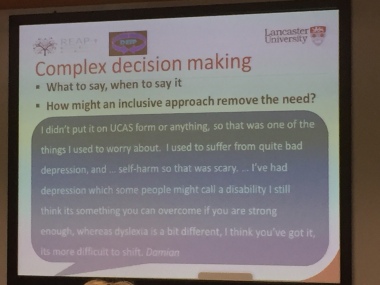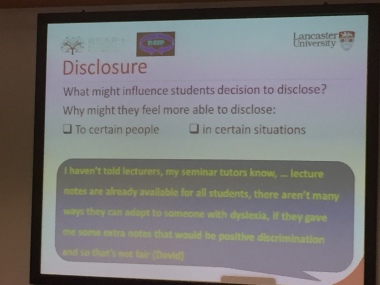
Many of the issues were simply good practice and would help all students and not just students with specific access requirements
Part One inclusion/exclusion issues with chairs offered first thoughts from the Inclusive Teaching and Learning Conference. Part Two contains further reflections and takeaways.
Alan Hurst opened the Inclusive Teaching and Learning Conference at York St John with a reference to Michael Oliver. Great call! Oliver’s influence with regard to the construction and promotion of the social model of disability in HE was a transformational threshold. This transferred the cause of inaccessibility from the individual to the environment where barriers to participation could be physical and/or cultural; a huge step from a deficit model whereby the ‘problem’ was perceived to be caused by individual impairment. Adoption of the social model led to major changes to the built environment; ramps into public buildings, installation of lifts, accessible facilities and (marking the early days of the internet, when Tim Berners Lee led on digital democracy) the World Wide Web Consortium (W3C) and Web Accessibility Initiative (WAI).

I didn’t hear the social model mentioned again.
Other takeaways for me included a reminder of Universal Design in Higher Education: From Principles to Practice (2008) – all HEI should have a copy. Where is the UK equivalent?
Inclusive teaching needs building in (like the production of transcripts or other textual equivalents) to the learning design, not added at the end. Bolt-on methods can be better than nothing but are never seamless and prone to dropping off.
Inclusive teaching means stop making assumptions. We are all different. Individual needs may be invisible. Where they are public (assistance dog, wheelchair, amputation) associated needs might not be what you think. Start a conversation about preferences for learning.
Prof Ann-Marie Houlton used the analogy of a kaleidoscope in her keynote. It worked well. Turn the tube. Click. Different pattern. Effective learning design is a kaleidoscope. It offers with diversity but all the pieces you need are already there.

The institution of higher education (HE) is a beast; large, old, traditional, eclectic and so on…. Changing the culture of HE presents complex challenges and no where is this more true than inclusion. I worry about society taking backwards steps rather than forward ones. Ideally, inclusion is holistic. The reality is inclusion being seen as something someone over there (not in my place) does for disabled students. Another blog post I think.
Inclusive teaching deserves a scholarly approach. Who is writing about inclusion these days?
Inclusive teaching involves understanding how language matters. Disabled students or students with disabilities? Inclusion as a disability issue or inclusion as universal design, an improved experience for all. The focus of the workshop Fostering inclusive language and behavior in the classroom was gender and sexuality; excellent places to start rethinking the roots of exclusive attitudes and practices (presenters Liesl King and Helen Sauntson used non-inclusive rather than exclusive – is this another linguistic shift? Should I stop referring to a an inclusion/exclusion binary?)

Language is the biggest building block in the world! It constructs self and reality. Perpetuates social stereotypes. Discourse analysis and visual literacies are valuable tools but who still uses them? Science is fighting back. Rationality rules. The further we move from the postmodern turn, the more single sources of truth take centre stage. We need to challenge this. We need to talk.
As always with conferences the best conversations took place around workshop tables and over lunch. I picked up some useful links including the Jisc InStep project looking at curriculum design and graduate attributes. From 2009, it’s judt as relevant today.
So what happens next – after the conference, still in the zone, feeling the buzz. What happens when we’ve thought about inclusion, reviewed programmes and practices, ticked the boxes – when do we stop?
The answer of course is never. Inclusive teaching should be agile, permanently in beta, continually under development. Each year every class and cohort is different. You wouldn’t have a fixed approach to your teaching (would you?) and it’s the same with inclusion.
HE is a rite of passage but the path can be tricky. Sometimes blockages happen or barriers inadvertently reinforced. It would be good to see more inclusive T&L conferences, including opportunities to talk to students about their own experiences. Inclusive teaching is about listening.



Finally, inclusive teaching is about what we do. Let’s have more conferences around learning designs – so long as one of its pillars is inclusive practice. Either way, did I mention this? – we really do need to talk.
images my own except medical and social model ones from http://ddsg.org.uk/taxi/medical-model.html
contact me for full text version of slides s.watling@hull.ac.uk






